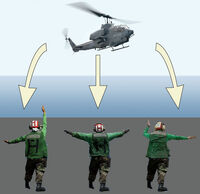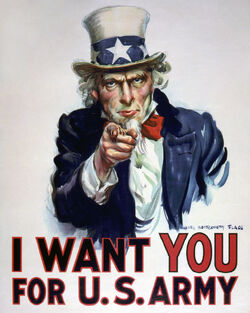Assessment |
Biopsychology |
Comparative |
Cognitive |
Developmental |
Language |
Individual differences |
Personality |
Philosophy |
Social |
Methods |
Statistics |
Clinical |
Educational |
Industrial |
Professional items |
World psychology |
Language: Linguistics · Semiotics · Speech

Military signalmen use hand and body gestures to direct flight operations aboard aircraft carriers.
A gesture is a form of non-verbal communication made with a part of the body, used instead of or in combination with verbal communication. The language of gesture is rich in ways for individuals to express a variety of feelings and thoughts, from contempt and hostility to approval and affection. Most people use gestures and body language in addition to words when they speak; some ethnic groups and languages use them more than others do, and the amount of such gesturing that is considered culturally acceptable varies from one location to the next.
Types of gestures
- Main article: Types of gestures

The ubiquitous act of pointing
Although some gestures, such as the ubiquitous act of pointing[1], differ little from one place to another, most gestures do not have invariable or universal meanings, having specific meanings and connotations only in certain cultures.
Different types of gestures are distinguished. A well-known type of gestures are the so-called emblems or quotable gestures (see the examples below). These are culture specific gestures that can be used as replacement for words. Communities have repertoires of such gestures. A single emblematic gesture can have very different significance in different cultural contexts, ranging from complimentary to highly offensive [2]
Another type of gestures are the ones we use when we speak. These gestures are closely coordinated with speech. The meaningful part of the gesture is temporally synchronized (that is, occurs at the same time) with the co-expressive parts of speech. For example, a gesture that depicts the act of throwing will be synchronous with the word 'threw' in the utterance "and then he threw the ball right into the window." Other gestures like the so-called beat gestures, are used in conjunction with speech, keeping time with the rhythm of speech to emphasize certain words or phrases. These types of gestures are integrally connected to speech and thought processes. [3]
Studies of gesture
Gestures have been studied throughout the centuries from different view points. [4] Quintillian in the antiquity studied in his Institution Oratoria how gesture may be used in rhetorical discourse. The another broad study of gesture was published by John Bulwer in 1644.[5] Bulwer analyzed dozens of gestures, and provided a guide on how to use gestures to increase eloquence and clarity for public speaking. Today, one of the most prominent researchers in the field of gesture research is Adam Kendon. He has investigated many aspects of gestures, including their role in communication, conventionalization of gesture, integration of gesture and speech, and the evolution of language [6]. Other prominent researchers in this field include Susan Goldin-Meadow and David McNeill. Susan Goldin-Meadow (2003) has investigated intensively the role of gesture in problem solving in children[7]. David McNeill (1992, 2006)[8] has developed a broad theory about how gesture and speech are part of a single thought process.
Social significance

Vitarka mudra, Tarim Basin, 9th century.
Gestures play a major role in many aspects of human life. Gesturing is probably a universal, there has been no report of a community that does not gesture.
Gestures are a crucial part of everyday conversation. Chatting, describing a route, negotiating prices on a market, they are ubiquitous.
Gestures play a central role in religious or spiritual rituals such as the Christian sign of the cross. In Hinduism and Buddhism, a mudra (Sanskrit, literally "seal") is a symbolic gesture made with the hand or fingers. Each mudra has a specific meaning, playing a central role in Hindu and Buddhist iconography. An example is the Vitarka mudra, the gesture of discussion and transmission of Buddhist teaching. It is done by joining the tips of the thumb and the index together, while keeping the other fingers straight.
Gestures are documented in the arts such as in Greek vase paintings, Indian Miniatures or European paintings.
Hand gestures
- Main article: Hand gesture
Hand gestures, i.e., gestures performed by one or two hands, is the most numerous category of gestures due to the ability of the human hand to acquire a huge number of clearly discernible configurations, the fact of importance for the sign languages. The latter ones are not discussed in this article.
Body gestures
Mooning
Mooning is the act of displaying one's bare buttocks by lowering the back side of one's trousers and underpants, usually without exposing the genitals. Mooning is used in some cultures to express protest, scorn, disrespect, or provocation. It can also be done for shock value or fun.
Anasyrma
Anasyrma or "lifting the skirts" is a gesture traceable to European antiquity. It is used in connection with certain religious rituals, eroticism, and lewd jokes.
The "peacock"
Expresses superiority or domination combined with a certain degree of smug arrogance. Performed by pushing the chest up and out at the front as well as tilting the face slightly upward. This may be accompanied by motions of hooking both thumbs under one's lapels or suspenders even if they are not present.
Head/face gestures
Facial expressions
Facial expressions are a rich language in their own right and will not be discussed in this article. Some facial expressions are byproducts of emotions, while others, such as winking or eye-rolling are akin to gestures.
Eye-rolling

Rolling one's eyes can express exasperation or condescension.
Rotating the eyes upward may have the following meanings.
- It may indicate condescension, contempt, boredom, or exasperation. This is often referred to as "rolling ones eyes to Heaven,"[How to reference and link to summary or text] as though wishing for a divine intervention for a rescue from boredom or frustration. It may also be accompanied by the head thrown backwards.
- Rolling eyes up with head slightly risen up, as if pointing upwards, may be the reference to people in higher hierarchy, e.g., upper management.
- See also: eye roll test
Nodding
A nod is a gesture of confirmation in many cultures and negation in some (e.g., in Bulgaria and Sri Lanka).
Bent head
A gesture of shame, subduing, or agreement/confirmation. An interpretation depends on the way it being performed and overall body context. Or, can be used as a greeting.
Head shaking
Head shaking, i.e., repeated alternating bending of the head to the left and to the right means disapproval in some cultures, e.g., in the East Slavic culture.
Head turning
Repeated turning of the head side to side has a meaning opposite to the nod: negation in many cultures and confirmation in some.
Pointing by chin
A direction may be pointed by chin, e.g., when the arms are doing something else: the head is turned in the corresponding direction and the chin is slightly jerked up and in the pointed direction. This is also used as a greeting in some regions in the U.S., usually among young men.
Hello by nod
A single nod of the head, (one single cycle in image-pitch) characterizes the hello gesture.[9]
See also
- List of gestures
- Kinesics
- Rock, Paper, Scissors, a game played with hand gestures
- Sign language
- Charades
- Chironomia
- Diving signal
- Talk to the hand
- Metacommunicative competence
- Taunt
- Musical Gestures
- Body language
References
- ↑ Kita, S. (ed.) (2003). Pointing: Where Language, Culture and Cognition Meet. Lawrence Erlbaum Associates, ISBN 0-8058-4014-1
- ↑ Morris, Desmond, Collett, Peter, Marsh, Peter, O'Shaughnessy, Marie. 1979. Gestures, their origins and distribution. London. Cape
- ↑ McNeill (1992). Hand and Mind. Chicago: University of Chicago Press
- ↑ Kendon, A. (1982). The study of gesture: Some observations on its history. Recherches Sémiotiques/Semiotic Inquiry 2 (1)
- ↑ Bulwer, John (1644). "Chirologia: or the Naturall Language of the Hand" (London,1644)
- ↑ Kendon (2004). Gesture: Visible Action as Utterance. Cambridge: Cambridge University Press
- ↑ Goldin-Meadow, Susan (2003). Hearing gesture: How our hands help us think. Cambridge, MA: Harvard University Press
- ↑ # McNeill, David (1992). Hand and Mind. What Gestures Reveal about Thought. Chicago: Chicago University Press. McNeill, David (2005). Gesture and Thought. Chicago: Chicago University Press
- ↑ Recognition of Head Gestures Using Hidden Markov Models.
- Bulwer, John (1644). "Chirologia: or the Naturall Language of the Hand" (London,1644)
- Goldin-Meadow, Susan (2003). The resilience of language: What gesture creation in deaf children can tell us about how all children learn language. In the Essays in Developmental Psychologyseries (J. Werker & H. Wellman, Eds.). New York: Psychology Press.
- Goldin-Meadow, Susan (2003). Hearing gesture: How our hands help us think. Cambridge, MA: Harvard University Press.
- Johns, C. (1982). Sex or Symbol. Erotic Images of Greece and Rome. London: British Museum Publications.
- Kendon, Adam (ed.) (1981). Nonverbal Communication, Interaction and Gesture: Selections from Semiotica (Vol.41, Approaches to Semiotics). The Hague: Mouton and Co. [Includes as an Introduction by Kendon an extended critical survey of methodological and theoretical issues in the field].
- Kendon, Adam (1997). Annual Review of Anthropology. 26: 109-128.
- Kendon, Adam (2000). Gesture in Naples and Gesture in Classical Antiquity. An English translation, with an Introductory Essay and Notes of La mimica degli antichi investigata nel gestire Napoletano ('Gestural expression of the ancients in the light of neapolitan gesturing') by Andrea de Jorio (1832). Bloomington, Indiana: Indiana University Press.
- Kendon, Adam (2004). Gesture: Visible Action as Utterance. Cambridge: Cambridge University Press.
- McNeill, David (1992). Hand and Mind. What Gestures Reveal about Thought. Chicago: Chicago University Press.
- McNeill, David (2005). Gesture and Thought. Chicago: Chicago University Press.
- Kita, S. (ed.) (2003). Pointing: Where Language, Culture and Cognition Meet. Lawrence Erlbaum Associates, ISBN 0-8058-4014-1.
External links
- International Society for Gesture Studies(ISGS) is an international scholarly association devoted to the study of human gesture. The ISGS organizes conferences and supports the Journal GESTURE.
- McNeill Lab Center for Gesture and Speech Research David McNeill's Lab homepage: The Center for Gesture and Speech Research at the University of Chicago studies speech and gesture from a psycholinguistic perspective. The page provides lots of useful information about gesture analysis.
- The Goldin-Meadow Lab Susan Goldin-Meadow's Lab homepage. The lab is composed of graduate students and researchers pursuing independent topics related to cognition, development, education, linguistics, and various other fields, but interrelated by the lab's main focus - the study of non-verbal communication, specifically gestures.
- The Nijmegen Gesture Center (NGC) at the Max Planck Institute for Psycholinguistics studies the role of gestures in psycholinguistic processing, communication and interaction, acquisition, cognition, and neurocognition.
- Journal GESTURE is a scholarly Journal that publishes articles reporting original research, as well as survey and review articles, on all aspects of gesture.
- Publications by Adam Kendon (field data, research techniques and theory of gesture and sign languages)
- A Nice Gesture Many stories and anecdotes on gestures.
- A Repertoire of South African Quotable Gestures, Journal of Linguistic Anthropology.
- Handspeak Sign languages, gestures, body languages, Baby Sign, International Sign, and more. Paid site with limited content for free.
Gestures | ||
|---|---|---|
| Friendly gestures |
A-ok · Air kiss · Big up · Cheek kissing · Dap greeting · Thumbs up · Fist pound · Namaste · High five |
 |
| Formal gestures |
Bowing · Curtsey · Hand-kissing · Genuflection | |
| Salutes |
Salute · Bellamy salute · Final Salute · Hitler salute · Roman salute · Royal Salute · Scout sign and salute · Three-finger salute · Two-fingers salute | |
| Celebration gestures |
Applause · Fist pump · Gig 'em Aggies · High five · Hook 'em Horns | |
| Obscene gestures |
Bowfinger · Corna · Finger · Mooning · Shocker · Moutza | |
| Other |
Air quotes · Anasyrma · Articulatory gestures · Crossed fingers · Gang signal · Hand gesture · Head bobble · Jazz hands · Lock and fly · Manual communication · Mudra · Nod · Poke · Pollice verso · Puppy face · Raised fist · Shaka sign · Shrug · Sign of the Cross · Thai greeting · Type of gesture · Varadamudra · V sign · Vulcan salute · War Chant · | |
| List of gestures | ||
| This page uses Creative Commons Licensed content from Wikipedia (view authors). |
